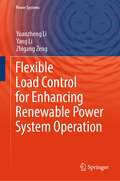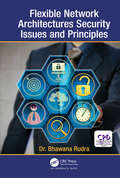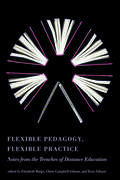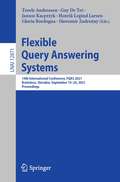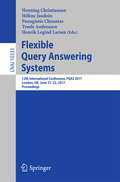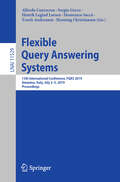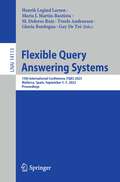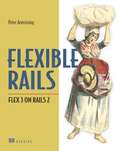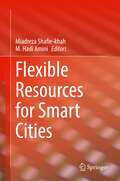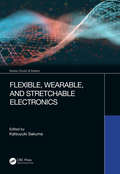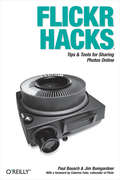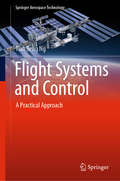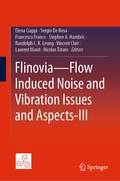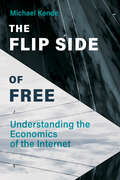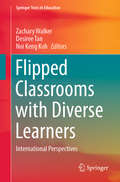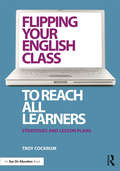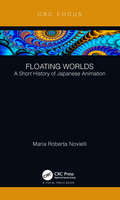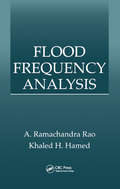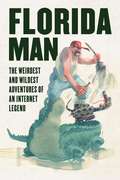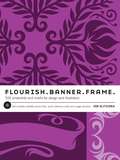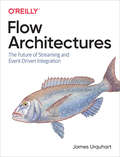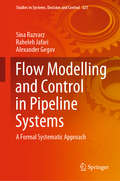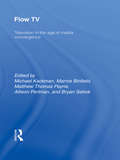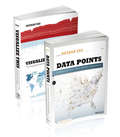- Table View
- List View
Flexible Load Control for Enhancing Renewable Power System Operation (Power Systems)
by Yuanzheng Li Yang Li Zhigang ZengThis book addresses the pressing challenges faced by renewable power system operation (RPSO) due to the increasing penetration of renewable energy and flexible load. These challenges can be divided into two categories. Firstly, the inherent uncertainties associated with renewable energy sources pose significant difficulties in RPSO. Secondly, the presence of various types of flexible load, along with their complex constraint relationships, adds to the operational complexities. Recognizing the growing emphasis on the economic and low-carbon aspects of RPSO, this book focuses on the key issues of flexible load control. It mainly consists of following categories: (1) The control of data centers, a booming flexible load, to enhance RPSO through renewable energy integration and advanced robust multi-objective optimization. (2) The introduction of flexible industrial load control, employing effective demand-supply cooperative responding strategies for RPSO. (3) The exploration of electricvehicle flexible charging load control and centralized electric vehicle charging system control in the context of RPSO. The book also covers the emerging field of flexible integrated load control for renewable energy-based comprehensive energy system operation. Aimed at researchers, engineers, and graduate students in electrical engineering and computer science, this book provides a valuable resource for understanding and implementing flexible load control in the context of RPSO.
Flexible Network Architectures Security: Principles and Issues
by Bhawana RudraThe future of Internet security doesn’t lie in doing more of the same. It requires not only a new architecture, but the means of securing that architecture. Two trends have come together to make the topic of this book of vital interest. First, the explosive growth of the Internet connections for the exchange of information via networks increased the dependence of both organizations and individuals on the systems stored and communicated. This, in turn, has increased the awareness for the need to protect the data and add security as chief ingredient in the newly emerged architectures. Second, the disciplines of cryptography and network security have matured and are leading to the development of new techniques and protocols to enforce the network security in Future Internet. This book examines the new security architectures from organizations such as FIArch, GENI, and IETF and how they’ll contribute to a more secure Internet.
Flexible Pedagogy, Flexible Practice: Notes from the Trenches of Distance Education
by Elizabeth Burge Chère Campbell Gibson Terry GibsonFlexibility has become a watchword in modern education, but its implementation is by no means a straightforward matter. Flexible Pedagogy, Flexible Practice sheds light on the often taken-for-granted assumptions that inform daily practice and examines the institutional dynamics that help and hinder efforts toward flexibility. The collection in international in scope, drawing on the experience of specialists in distance education from North America, the United Kingdom, Australia and New Zealand, South Africa, Singapore, and Japan. Contributors to the volume were asked to reflect candidly and critically on a series of questions, including: What precisely is flexible learning? Who or what is driving the flexibility agenda, and for whose benefit? And who or what is resisting it? What challenges must be overcome in order to achieve flexibility, and what are some of the compromises it can entail?
Flexible Query Answering Systems: 14th International Conference, FQAS 2021, Bratislava, Slovakia, September 19–24, 2021, Proceedings (Lecture Notes in Computer Science #12871)
by Troels Andreasen Guy De Tré Janusz Kacprzyk Henrik Legind Larsen Gloria Bordogna Sławomir ZadrożnyThis book constitutes the refereed proceedings of the 14th International Conference on Flexible Query Answering Systems, FQAS 2021, held virtually and in Bratislava, Slovakia, in September 2021.The 16 full papers and 1 perspective papers presented were carefully reviewed and selected from 17 submissions. They are organized in the following topical sections: model-based flexible query answering approaches and data-driven approaches.
Flexible Query Answering Systems
by Henning Christiansen Hélène Jaudoin Panagiotis Chountas Troels Andreasen Henrik Legind LarsenThisvolumeconstitutestheproceedingsoftheFifthInternationalConferenceon Flexible Query Answering Systems, FQAS 2002, held in Copenhagen, Denmark on October 27-29, 2002. FQAS is the premier conference for researchers and practitioners concerned with the vital task of providing easy, ?exible, and intuitive access to information for every type of need. This multidisciplinary conference draws on several re- arch areas, including databases, information retrieval, knowledge representation, soft computing, multimedia, and human-computer interaction. Previous FQAS events were held in 1994, 1996, 1998, and 2000. The overall theme of the FQAS conferences is innovative query systems - medatprovidingeasy,?exible,andintuitiveaccesstoinformation. Suchsystems are intended to facilitate retrieval from information repositories such as data- ses,libraries,andtheWorld-WideWeb. Theserepositoriesaretypicallyequipped with standard query systems which are often inadequate, and the focus of FQAS is the development of query systems that are more expressive, informative, c- perative, and productive. These proceedings contain 29 original papers that relate to the topic of users posing queries and systems producing answers. The papers cover the ?elds: - tabase Management, Information Retrieval, Domain Modeling, Knowledge - presentation and Ontologies, Knowledge Discovery and Data Mining, Arti?cial Intelligence, Classical and Non-classical Logics, Computational Linguistics and Natural Language Processing, Multimedia Information Systems, and Human- Computer Interaction. We wish to thank the contributors for their excellent papers and the referees, publisher, and sponsors for their e?ort. Special thanks also to the invited sp- kers, members of the Advisory Board, and members of the Program Committee. They made the success of FQAS 2002 possible.
Flexible Query Answering Systems: 13th International Conference, FQAS 2019, Amantea, Italy, July 2–5, 2019, Proceedings (Lecture Notes in Computer Science #11529)
by Alfredo Cuzzocrea Sergio Greco Henrik Legind Larsen Domenico Saccà Troels Andreasen Henning ChristiansenThis book constitutes the refereed proceedings of the 13th International Conference on Flexible Query Answering Systems, FQAS 2019, held in Amantea, Italy, in July 2019.The 27 full papers and 10 short papers presented were carefully reviewed and selected from 43 submissions. The papers present emerging research trends with a special focus on flexible querying and analytics for smart cities and smart societies in the age of big data. They are organized in the following topical sections: flexible database management and querying; ontologies and knowledge bases; social networks and social media; argumentation-based query answering; data mining and knowledge discovery; advanced flexible query answering methodologies and techniques; flexible query answering methods and techniques; flexible intelligent information-oriented and network-oriented approaches; big data veracity and soft computing; flexibility in tools; and systems and miscellanea.
Flexible Query Answering Systems: 15th International Conference, FQAS 2023, Mallorca, Spain, September 5–7, 2023, Proceedings (Lecture Notes in Computer Science #14113)
by Henrik Legind Larsen Maria J. Martin-Bautista M. Dolores Ruiz Troels Andreasen Gloria Bordogna Guy De TréThis book constitutes the refereed proceedings of the 15th International Conference on Flexible Query Answering Systems, FQAS 2023, held in September 2023 in Palma de Mallorca, Spain. The 24 full papers presented were carefully reviewed and selected from numerous submissions. They are organized in the following topical sections: Flexible Queries over Semantic Systems; Advanced Methods and Applications in Natural Language; Processing (NLP); New Advances in Disinformation Detection; Data and Text Mining; Applying AI to Social Science and Social Science to AI; Artificial Intelligence Law and Regulation.
Flexible Rails: Flex 3 on Rails 2
by Peter ArmstrongFlexible Rails is a unique, application-based guide for using Ruby on Rails 2 and Adobe Flex 3 to build rich Internet applications (RIAs). It is not an exhaustive Ruby on Rails or Flex reference. Instead, it is an extensive tutorial in which the reader builds multiple iterations of an interesting RIA using Flex and Rails together.Author Peter Armstrong walks readers through eleven iterations in which the sample application—pomodo—is variously built, refactored, debugged, sliced, diced and otherwise explored from every conceivable angle with respect to Ruby on Rails and Adobe Flex. The book unfolds both the application and the Flex-on-Rails approach side-by-side. Purchase of the print book comes with an offer of a free PDF, ePub, and Kindle eBook from Manning. Also available is all code from the book.
Flexible Resources for Smart Cities
by Miadreza Shafie-Khah M. Hadi AminiThis book paves the road for researchers from various areas of engineering working in the realm of smart cities to discuss the intersections in these areas when it comes to infrastructure and its flexibility. The authors lay out models, algorithms and frameworks related to the ‘smartness’ in the future smart cities. In particular, manufacturing firms, electric generation, transmission and distribution utilities, hardware and software computer companies, automation and control manufacturing firms, and other industries will be able to use this book to enhance their energy operations, improve their comfort and privacy, as well as to increase the benefit from the electrical system. The book pertains to researchers, professionals, and R&D in an array of industries.
Flexible, Wearable, and Stretchable Electronics (Devices, Circuits, and Systems)
by Katsuyuki Sakuma Krzystof IniewskiRemarkable progress has been achieved within recent years in developing flexible, wearable, and stretchable (FWS) electronics. These electronics will play an increasingly significant role in the future of electronics and will open new product paradigms that conventional semiconductors are not capable of. This is because flexible electronics will allow us to build flexible circuits and devices on a substrate that can be bent, stretched, or folded without losing functionality. This revolutionary change will impact how we interact with the world around us. Future electronic devices will use flexible electronics as part of ambient intelligence and ubiquitous computing for many different applications such as consumer electronics, medical, healthcare, and security devices. Thus, these devices have the potential to create a huge market all over the world. Flexible, Wearable, and Stretchable Electronics, provide a comprehensive technological review of the state-of-the-art developments in FWS electronics. This book offers the reader a taste of what is possible with FWS electronics and describes how these electronics can provide unique solutions for a wide variety of applications. Furthermore, the book introduces and explains new applications of flexible technology that has opened up the future of FWS electronics.
Flickr Hacks
by Jim Bumgardner Paul BauschOver two million registered Flickr users and counting have discovered the ease and fun of organizing their photo libraries, showing off their favorite pictures to the world, and securely sharing their private pictures with friends, family, or ad hoc groups. But Flickr's own plethora of intuitive menus, options, and features just scratches the surface. Flickr Hacks goes beyond the basics of storing, sorting, and sharing your photos to the much bigger playground of what's possible. Whether you're a beginner looking to manage your metadata and play with tags, or a programmer in need of a detailed reference of Flickr API methods, you'll find what you're looking for here. In addition to getting under the hood of some of the most popular third-party Flickr toys already in the wild, you'll learn how to: Post photos to your blog directly from your cameraphone Mash up your own photos or others' public pictures into custom mosaics, collages, sliding puzzles, slideshows, or ransom notes Back up your Flickr library to your desktop, and save the comments too Set random desktop backgrounds and build your own Flickr screensaver Geotag your photos and map your contacts Download a list of photos and make a contact sheet Make your own Flickr-style tag cloud to visualize the frequency of common tags Build a color picker with a dynamic color wheel of Flickr photos Feed photos to your web site and subscribe to custom Flickr feeds using RSS Talk to the Flickr API using your web browser, Perl, or PHP; authenticate yourself and other users; and build custom API applications
Fliegen lernen: Flugsimulation mit Microsoft Flight Simulator, X-Plane, AeroflyFS und FlightGear
by Mario DonickFliegen fasziniert Menschen seit Angedenken. Seit es Computer gibt, versuchen Menschen das Fliegen am Computer nachzustellen – zur Ausbildung, aber auch zur Unterhaltung und um hinter die Geheimnisse der Luftfahrt zu blicken.Mit dem neuen Microsoft Flight Simulator 2020 begann im August 2020 ein neues Kapitel der Flugsimulation an PC und Spielkonsole: Noch nie war die Weltdarstellung so realistisch, noch nie das simulierte Wetter so plausibel, noch nie die Simulation so zugänglich. Doch auch X-Plane, AeroflyFS und das kostenlose FlightGear sind ideale Werkzeuge zur persönlichen Weiterbildung und zum virtuellen Erkunden unserer Erde.In diesem Buch lernen Sie Flugsimulation von Grund auf und dabei auch einiges über die Luftfahrt selbst: Warum fliegt ein Flugzeug? Welche Rolle spielt das Wetter? Wie finden Pilot*innen ihren Weg? Was geschieht bei Notfällen? Diese und weitere Themen werden praxisnah abgehandelt, sodass Sie alles selbst ausprobieren können – egal welchen der genannten Simulatoren Sie nutzen.Die Website zum Buch finden Sie unter https://ueberstrom.net/fliegen/.
Flight Systems and Control: A Practical Approach (Springer Aerospace Technology)
by Tian Seng NgThis book focuses on flight vehicles and their navigational systems, discussing different forms of flight structures and their control systems, from fixed wings to rotary crafts. Software simulation enables testing of the hardware without actual implementation, and the flight simulators, mechanics, glider development and navigation systems presented here are suitable for lab-based experimentation studies. It explores laboratory testing of flight navigational sensors, such as the magnetic, acceleration and Global Positioning System (GPS) units, and illustrates the six-axis inertial measurement unit (IMU) instrumentation as well as its data acquisition methodology. The book offers an introduction to the various unmanned aerial vehicle (UAV) systems and their accessories, including the linear quadratic regulator (LQR) method for controlling the rotorcraft. It also describes a Matrix Laboratory (MATLAB) control algorithm that simulates and runs the lab- based 3 degrees of freedom (DOF) helicopter, as well as LabVIEW software used to validate controller design and data acquisition. Lastly, the book explores future developments in aviation techniques.
Flinovia—Flow Induced Noise and Vibration Issues and Aspects-III
by Elena Ciappi Sergio De Rosa Francesco Franco Stephen A. Hambric Randolph C. K. Leung Vincent Clair Laurent Maxit Nicolas TotaroThis volume gathers the latest advances and innovations in the field of flow-induced vibration and noise, as presented by leading international researchers at the 3rd International Symposium on Flow Induced Noise and Vibration Issues and Aspects (FLINOVIA), which was held in Lyon, France, in September 2019. It explores topics such as turbulent boundary layer-induced vibration and noise, tonal noise, noise due to ingested turbulence, fluid-structure interaction problems, and noise control techniques. The authors’ backgrounds represent a mix of academia, government, and industry, and several papers include applications to important problems for underwater vehicles, aerospace structures and commercial transportation. The book offers a valuable reference guide for all those interested in measurement, modelling, simulation and reproduction of the flow excitation and flow induced structural response.
The Flip Side of Free: Understanding the Economics of the Internet
by Michael KendeWhy "free" comes at a price: the costs of free internet services in terms of privacy, cybersecurity, and the growing market power of technology giants.The upside of the internet is free Wi-Fi at Starbucks, Facetime over long distances, and nearly unlimited data for downloading or streaming. The downside is that our data goes to companies that use it to make money, our financial information is exposed to hackers, and the market power of technology companies continues to increase. In The Flip Side of Free, Michael Kende shows that free internet comes at a price. We're beginning to realize this. Our all-purpose techno-caveat is "I love my smart speaker...but"--is it really tracking everything I do? listening to everything I say?
Flipped Classrooms with Diverse Learners: International Perspectives (Springer Texts in Education)
by Noi Keng Koh Zachary Walker Desiree TanThis book addresses the background of classroom flipping, explores the theoretical underpinnings for why flipping works, and shares current success stories in practice. It provides diverse international examples of classroom flipping for all ages, includes discussions of the authors’ studies in the context of the existing research, and illustrates the impact that classroom flipping has had across a range of educational settings instead of focusing on a specific domain or learner context. Intended as a handbook for practitioners, the analysis of commonly used, highly effective techniques for learners of various ages fills a major gap in the literature. It offers a valuable resource for educators, helping them make the flipped learning experience an impactful and meaningful one.
Flipping Your English Class to Reach All Learners: Strategies and Lesson Plans
by Troy CockrumLearn how flipping your English language arts classroom can help you reach students of different abilities, improve classroom management, and give you more time to interact with each student. This practical book shows why flipped classrooms are effective and how they work. You will find out how to flip your instruction in writing, reading, language, and speaking and listening while meeting the Common Core State Standards. A variety of step-by-step lesson plans are provided.
Floating Worlds: A Short History of Japanese Animation (Focus Animation Ser.)
by Maria Roberta NovielliThrough the analysis of the work of the main Japanese animators starting from the pioneers of 1917, the book will overview the whole history of Japanese animated film, including the latest tendencies and the experimental movies. In addition to some of the most acclaimed directors Miyazaki Hayao, Takahata Isao, Shinkai Makoto, Tezuka Osamu and Kon Satoshi, the works of masters of animation such as Kawamoto Kihachirō, Kuri Yōji, Ōfuji Noburō and Yamamura Kōji will be analysed in their cultural and historical context. Moreover, their themes and styles will be the linking thread to overview the Japanese producing system and the social and political events which have often influenced their works. Key Features Insight into both mainstream and independent cinema Scientific reliability Easy readability Social and cultural context
Flood Frequency Analysis
by A. Ramachandra Rao Khaled H. HamedAfter five decades, the field of Statistical Hydrology continues to evolve and remains a very active area of investigation. Researchers continue to examine various distributions, methods of estimation of parameters, and problems related to regionalization. However, much of this research appears in journals and reports and usually in a form not easi
Florida Man: The Weirdest and Wildest Adventures of an Internet Legend
by Skyhorse PublishingA full year's worth of the strangest, most outlandish antics of one of the Internet's true titans: Florida Man! Plus, for the first time ever . . . the equally bizarre, equally outrageous Florida Woman! Go to Google and type in your birth date and the words "Florida Man." Weird, right? Well, you haven't seen anything yet! That's just one day in the life of a Florida Man. Originally a beloved Internet game made possible by Florida's Sunshine Laws, "Florida Man" has now become a phrase unto itself, a shorthand expression used online to capture the antics of Florida's residents, who somehow seem to find themselves in bizarre situations regularly. Now, Florida Man is here to collect the 366 greatest, most unusual adventures of both Florida Man and Florida Woman, sorted day-by-day from January 1 through December 31st. (Plus, special leap-year headlines for those readers who just can't get enough mayhem during the regular year!)Florida Man features headlines such as: "Florida Man Throws Alligator Into Wendy&’s Drive-Thru Window"&“Florida Man Shoots Self, Realizes it Three Days Later&”"How Trump Became a Florida Man"plus, corresponding Florida Woman headlines like "Florida woman attacked by &‘aggressive&’ otter says 'severe bites' left her temporarily unable to walk&” This collection of classic Florida weirdness will astound and amuse even the most jaded, world-weary reader. Just don't go trying any of Florida Man's—or Florida Woman's—ideas for yourself!
Flourish. Banner. Frame.: 615 Ornaments and Motifs for Design and Illustration
by Glitschka VonOrnaments and motifs add something special to creative projects, but not all creatives can devote the hundreds of hours necessary to developing them. Flourish. Banner. Frame. is an amazing library of 555 original symbols, floral motifs, border treatments, frills, banners, shields, crests, ornaments, decorative frames, placards and cartouches. Each design element has been crafted with vector precision, and you can use this artwork within the context of your own projects, whether they are personal or professional in nature.There are 10 real-life examples in the book, so you can be inspired by top designers and illustrators. This extensive volume of ornaments and motifs is easy to use for any design or illustration project: publication layouts, book covers, website backgrounds, t-shirt graphics, scrapbooks, textiles, crafts, stencils, tattoos-and everything in between. Whether you are a beginner or an advanced design professional, you’ll turn to this resource again and again for years to come.Royalty-free ornaments included on DVD for your use!
Flow Architectures: The Future Of Streaming And Event-driven Integration
by James UrquhartSoftware development today is embracing events and streaming data, which optimizes not only how technology interacts but also how businesses integrate with one another to meet customer needs. This phenomenon, called flow, consists of patterns and standards that determine which activity and related data is communicated between parties over the internet.This book explores critical implications of that evolution: What happens when events and data streams help you discover new activity sources to enhance existing businesses or drive new markets? What technologies and architectural patterns can position your company for opportunities enabled by flow? James Urquhart, global field CTO at VMware, guides enterprise architects, software developers, and product managers through the process.Learn the benefits of flow dynamics when businesses, governments, and other institutions integrate via events and data streamsUnderstand the value chain for flow integration through Wardley mapping visualization and promise theory modelingWalk through basic concepts behind today's event-driven systems marketplaceLearn how today's integration patterns will influence the real-time events flow in the futureExplore why companies should architect and build software today to take advantage of flow in coming years
Flow Modelling and Control in Pipeline Systems: A Formal Systematic Approach (Studies in Systems, Decision and Control #321)
by Sina Razvarz Raheleh Jafari Alexander GegovThis book introduces novel methods for leak and blockage detection in pipelines. The leak happens as a result of ageing pipelines or extreme pressure forced by operational error or valve rapid variation. Many factors influence blockage formation in pipes like wax deposition that leads to the formation and eventual growth of solid layers and deposition of suspended solid particles in the fluids. In this book, initially, different categories of leak detection are overviewed. Afterwards, the observability and controllability of pipeline systems are analysed. Control variables can be usually presented by pressure and flow rates at the start and end points of the pipe. Different cases are considered based on the selection of control variables to model the system. Several theorems are presented to test the observability and controllability of the system. In this book, the leakage flow in the pipelines is studied numerically to find the relationship between leakage flow and pressure difference. Removing leakage completely is almost impossible; hence, the development of a formal systematic leakage control policy is the most reliable approach to reducing leakage rates.
Flow TV: Television in the Age of Media Convergence
by Michael KackmanFrom viral videos on YouTube to mobile television on smartphones and beyond, TV has overflowed its boundaries. If Raymond Williams' concept of flow challenges the idea of a discrete television text, then convergence destabilizes the notion of television as a discrete object. Flow TV examines television in an age of technological, economic, and cultural convergence. Seeking to frame a new set of concerns for television studies in the 21st century, this collection of all new essays establishes television’s continued importance in a shifting media culture. Considering television and new media not as solely technical devices, but also as social technologies, the essays in this anthology insist that we turn our attention to the social, political, and cultural practices that surround and inform those devices' use. The contributors examine television through a range of critical approaches from formal and industrial analysis to critical technology studies, reception studies, political economy, and critiques of television's transnational flows. This volume grows out of the critical community formed around the popular online journal Flow: A Critical Form on Television and Media Culture (flowtv.org). It is ideal for courses in television studies or media convergence.
FlowingData.com Data Visualization Set
by Nathan YauVisualize This is a guide on how to visualize and tell stories with data, providing practical design tips complemented with step-by-step tutorials. It begins with a description of the huge growth of data and visualization in industry, news, and gov't and opportunities for those who tell stories with data. Logically it moves on to actual stories in data-statistical ones with trends and human stories. the technical part comes up quickly with how to gather, parse and format data with Python, R, Excel, Google docs, etc and details tools to visualize data-native graphics for the Web like ActionScript, Flash libraries, PHP, JavaScript, CSS, HTML. Every chapter provides an example as well. Patterns over time and kinds of data charts are followed by proportions, chart types and examples. Next, examples and descriptions of outliers and how to show them, different kinds of maps, how to guide your readers and explain the data "in the visualization". The book ends with a value-add appendix on graphical perception.Data Points focuses on the approach to visualization and data. Visualization is a medium that can be used as a tool, art, a way to tell stories, etc., Data Points guides readers through making data approachable through visualization techniques and best practices. The focus is on designing with a purpose in mind. Data Points discusses why recipes (from the rules) work and expands on how readers can make their own recipes. The book is example-driven, featuring work from people in areas of art, design, business, statistics, computer science, cartography, and online media, as well as many of the author's own illustrations. The major sections of the book cover:Visualization as Medium -- In the same way not all movies are documentaries, not all visualization is about optimal visual perception. Data Representation -- There are rules across all visualization applications, such as the use of appropriate shapes to accurately represent values.Design with Purpose -- Rules can be broken though. It all depends on who and what you're designing for.Data Points digs deep into the foundations of data visualization:Understanding Data and VisualizationRepresenting DataExploring Data VisuallyDesigning for an AudienceVisualizing with ClarityPutting Everything Into Practice with Tools and Resources
